Colonizing Mars: How Science Fiction Gets it Wrong
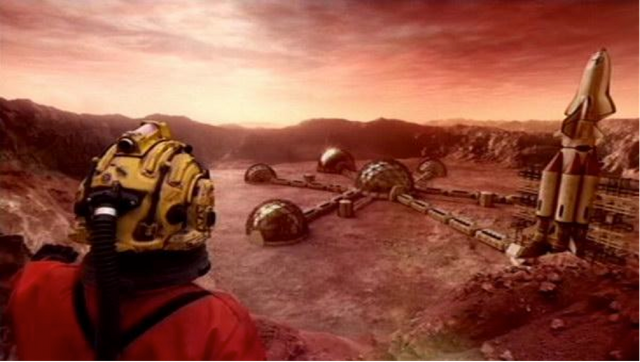
Put your torches and pitchforks away. Of course I am a proponent of human colonization of Mars, for the obvious survival insurance it confers to our species against meteorites, nuclear war, plagues or whatever else. What I am taking issue with in this post is how Mars colonies have been depicted in popular media versus how they will actually be built.
I should know, as not only a Mars and space settlement enthusiast but a former participant in the Mars Desert Research project, a simulated Mars habitat on the San Rafael swell of the Utah desert, just outside of Hanksville.
Most depictions of human habitats on Mars have been aluminum cylinders, the old "man in a can" approach, perhaps with inflatable expansions for cultivating edible vegetables. This is indeed perfectly sensible for a habitat sent by rocket and landed on the surface of Mars. NASA's own Desert RATS model mars habitat fits this description:
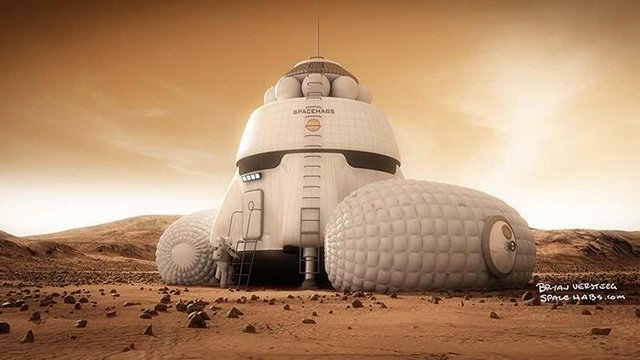
However, the assumption that a whole colony supporting hundreds or thousands of people could be built on Mars simply by landing more habitats and connecting them to one another is intensely naive. Imagine for example the expense of building an entire city this way, even on Earth, sending one room at a time by rocket.
It would bankrupt us! Many times over in fact unless it were done over many centuries. So when you imagine a colony on Mars, do not picture a sprawling network of interconnected metal structures. It is feasible from an engineering perspective, but not from an economic one.
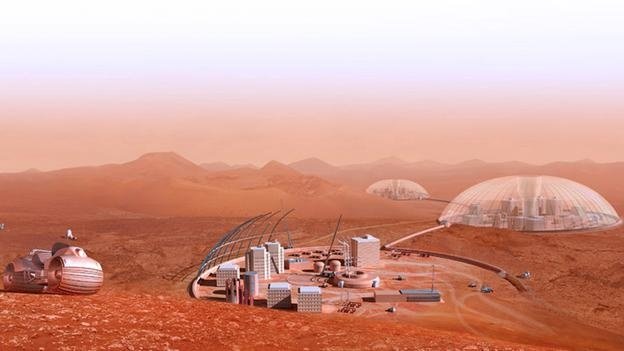
Conceptual Martian cities beneath domes, for example, make little sense. Given the insane cost per cubic foot of establishing shirtsleeves habitat space on the red planet, why would you construct conventional Earth style dwellings within a dome, rather than filling the dome with floor after floor to make full use of the interior volume?
Moreover, we cannot send what's needed for such large contiguous structures by rocket. So in order to even begin to think about establishing structures on that scale, there would need to be an already established Martian industrial infrastructure, which also requires a sizable established population. A solution to supporting all those lives without such elaborate, elegant enclosures is therefore needed.
The solution? Go underground! There are many confirmed lava tubes and cavern entrances on the Martian surface, identified by orbiters. Instead of bringing the entire habitat, why not find a "fixer-upper"? Seal the entrance after fitting it with an airlock. Compress ambient atmospheric CO2 and pump it into the interior until the pressure is Earth normal. Add electric lights and heaters powered by a nuclear reactor sent on a single lander, add nitrogen to the soil, then plant crops.
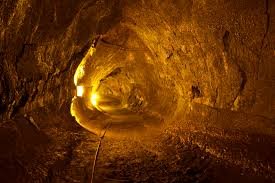
As the crops mature they will reprocess the CO2 atmosphere in the lava tube, displacing more and more of it with O2. Once it is breathable, humans could be introduced to counterbalance the plants. This would not need to be a perfect closed system; There is always more atmospheric CO2 outside that can be pumped in should the amount of O2 become excessive, and during periods of excess O2 production it can be compressed and stockpiled in tanks so that it can be released back into the environment during periods of O2 deficiency.
In this way, a comfortable living space vastly larger than any we could establish by connecting tin cans together could be established for a tiny fraction of the cost. Living underground would shield colonists from radiation which bombards the surface, and as most of what they will be there to do is mine metallic ores and smelt them into metals with which to construct surface settlements, it makes sense to house them on the work site.
Once all of this is done and we have mines, refineries, smelting plants and so on established on Mars as well as a population several thousand strong, it will become possible to produce the materials needed to construct surface settlements. But not before then! You have to walk before you can fly.
Surface settlements can consist of very Earthlike concrete buildings. Rectilinear with big, flat windows, as the pressure differential between the inside and outside won't be sufficiently strong to prevent it. This is why even the ISS has big, flat windows in the cupola module, as there's only a 14.7 psi differential between the atmosphere inside the ISS and the vacuum outside. That is roughly the same as the difference between the inside and outside of a bicycle inner tube.
Why concrete? Because it can be made out of Martian soil, or "regolith". The idea here is to use materials found on Mars to build more living space instead of sending prefabricated habitat modules by rocket. The resulting settlement would look nothing at all like this:
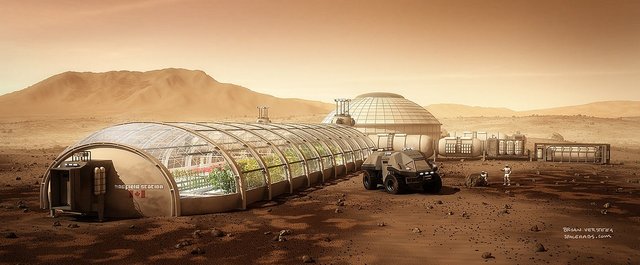
...But instead, more like this:

Just, y'know. Redder. However bleak it sounds to live in vast concrete cities on a barren, dead planet, that would in fact be the holy grail and intergenerational dream of the first wave of colonists. A better life for their kids or grandkids than they had underground. To live on the surface where there is natural sunlight, grand views of...well, radiation blasted red desert, and a return to a more Earthlike lifestyle.
That's all for now. See you on the red frontier. (⌐■‿■)

The only thing we need is lower cost ways to get off earth...
I'm working on that, I have some preliminary concepts and a gravity hypothesis. Once someone makes a way that lowers the cost of launch to the price of a long holiday on a carribean island, a lot more people can join in this. I like your ideas a lot, and I am pleased to read about other people who want to see a post-terrestrial human civilisation...
AirShip to DarkStation One, then Momentum Transfer Tether to orbit.
Launching from high altitude using balloons, it seems like a good theory, but I know of no tests of this theory yet. Helium is not cheap, and supposedly, hydrogen is very dangerous.
why do you say hydrogen is dangerous?
in fact, Liquid hydrogen and kerosene is what they use for fuel NOW,for rocket fuel. why should it be any more dangerous to use what is already being used but in lesser concentrations?
here you go
and
I know, it's a misconception. The mythbusters did a good one on the Hindenberg. It turned out that in fact the problem was the mix of aluminium and iron oxide used in the paint on the outside of it. This mix ignited because of static electricity, and it's basically thermite. Anyone who remembers at school dropping a small piece of zinc into hydrochloric acid and doing the 'pop test' would know that hydrogen does not burn slowly, it either explodes, or does nothing at all, it's optimal oxygen mix is very very tight. With careful engineering of a mix of CO2 or argon or so, you could make it nearly impossible for a hydrogen balloon to explode.
This idea makes a lot of sense, if you have something already in orbit, you can use its mass and orbital adjustments to allow it to swing quite a lot of weight up into orbit, and from there, well, even ion drives can push hard enough to get moving, and they have found now they don't even need a feed gas to push off with.
But the bigger problem, which has not been addressed, and which is why there is a shadow of doubt over the apollo missions, is that shielding against radiation is not sufficient without a lot of very heavy, very expensive lead and/or beryllium coatings. Simply flying regularly at 30,000 feet can raise your risk of developing cancer a lot.
Outside the earth's magnetosphere, this is even worse, and then, as you did mention, there is a further problem on Mars, whose magnetosphere is not sufficient. In fact, this is probably the main reason why mars is not teeming with life, and why theories of it ever having supported life are highly dubious, in my opinion. Earth is not just in the optimal temperature zone, it also has enough ferromagnetic materials in its core (mainly iron) that combined with its rotational momentum and seismic effect, produce a strong enough field to produce a magnetic shield against the radiation of the sun.
This will be the biggest problem with post-terrestrial migrations. I don't think it will be feasible in any large numbers until there is a cheap and effective radiation shield system.
a few feet of dirt and rock is pretty good shielding. On planets/moons with no/thin air living underground would seem to be the safest thing to do.
One other thing is odd.
Nitrogen.
Earth is the only major planet that has in it's atmosphere in any significant concentration. Every other planet either has none or very little. Then there' the . The moon Titan . Titan's atmosphere is thicker than earth's and has a LOT of nitrogen.
Does sound, pretty bleak... I was wondering about the sun and sunlight, up until the end of your piece. You gotta do, what you gotta do.., right? Very intriguing @alexbeyman
WOW Good stuff! I had been thinking some of the same things my own self!
Sign me up. Right now.
If mars, then why not the moon?
What has mars got too offer that the moon doesn't have too?
The moon is a LOT closer.
Moon has to little gravity. And people are trying to get as far away from earth as they can.
why do you consider low gravity to be a bug?
would you like to fly?
Imagine a huge under-moon room full of air.
In 1/6 th gravity, you could strap on wings....and FLY!
it's a feature.
If they want to get far, far away from earth.
Make an O'neill cylinder, put a NERVA on one end...
and go to another star.
it'd only take about 30,000 years.
Because human beings cannot reproduce in lunar gravity without the baby having serious deformities or being stillborn. That's why the Moon can't be a permanent home for humanity but Mars can. Mars also has a wider range of metals necessary for high tech civilization and atmospheric CO2 that can be used to nourish plants (after condensing and heating it obviously)
How do you know that to be true? Is there empirical evidence to support that claim? How big is the data sample?
Assuming that it's true what is the cut off point? How much gravity is required?
The moon is a 'meterorite catcher' for earth. It sweeps them out of the sky before they hit us. If it wasn't for the moon we'd have a LOT more impacts. Oddly enough there is a class of meteorite called 'carbonaceous chondrite'
note the word 'carbon'?
Most of them contain water or minerals that have been altered in the presence of water, and some of them contain larger amounts of carbon as well as organic compounds. This is especially true for the carbonaceous chondrites that have been relatively unaltered by heating during their history.
On earth most of the readily available metal is...guess what? It's mined from ancient meteor impacts. From orbital survey and observation the moon has been found to have a BUNCH of meteor craters. Gravitational anomalies , sometimes called mascons suggest that the impactors were dense. Metal perhaps?
The moon has a very thin atmosphere, almost none, that means that it receives the full impact of sunlight. Solar collectors, both voltaic and heat producing should work FINE. No attenuation due to atmosphere. That's a feature not a bug.
When digging out the tunnels for the habitations, the same as you suggest be done on mars, it would be easier without the extra gravity AND...all those mascons, a chemical supermarket full of metals and carbon...just sitting. there. The crust already has plenty of oxygen.
Making CO2 won't be hard.
Woah there. We're not fighting each other for dear life. This is just academic discussion. No need to be so defensive.
It was in a thing I read once. I don't remember specifics, it was many years ago and I didn't save it. It had to do with raising rats in microgravity, and in spinning centrifuges that could simulate the gravity on the Moon and Mars.
The thing about metal availability comes from something Robert Zubrin wrote. I don't know what he bases it on but I consider him an authority on the topic of Mars colonization.
It sounds like you are just very passionate for a Moon base. I didn't mean to diminish or step on that dream. No doubt there will one day be manned bases on the Moon.
sifi my interests!
Interesting article. Why not use 3d printers? There is already one that prints houses using mostly mud.
http://www.goodnewsnetwork.org/worlds-largest-3d-printer-makes-almost-zero-cost-homes-mud/
I would think something like this could be modified to build habitats on Mars, and would be easier than your method using concrete.
What do you think?
You can 3D print with concrete.
that's something similar to what Craig Venter proposes.
nice one!
@christoryan Is mind travel still just a theory or are "the flying brains" from Futurama a plausible means of space travel..?
...Mind....travel? I think to be a theory, it has to first start out as a hypothesis and then be confirmed by experiment. Could you describe what mind travel entails?
I agree with you
please like have me